Abstract
We examined the hypothesis that proton-potassium-activated adenosine triphosphatase (H-K-ATPase) mediates K absorption and acidification in the inner stripe of the outer medullary collecting duct (OMCDi). Rabbits were fed a low-K diet (0.55% K) for 7-14 d because we have demonstrated previously that this low-K diet stimulates K-absorptive flux by the OMCDi. Proton secretion was measured as net total CO2 flux (JTCO2) by microcalorimetry. After basal collections, either vehicle or an inhibitor of gastric H-K-ATPase, omeprazole (0.1 mM), was added to the perfusate during the second period. Addition of vehicle to the perfusate changed neither the transepithelial voltage (VT, in millivolts) nor the JTCO2. In contrast, the addition of omeprazole (0.1 mM) to the perfusate abolished JTCO2 (from 14.5 +/- 5.6 to -0.1 +/- 3.1 pmol.mm-1.min-1) without significantly affecting VT. In additional experiments, in 16 tubules there was significant net K absorption (JK) of 5.0 +/- 1.0 pmol.mm-1.min-1 during the basal period, which exceeded the rate of K absorption that could be attributed to a paracellular voltage-mediated pathway (JKP = 1.0 +/- 0.4 pmol.mm-1.min-1, P less than 0.01). Administration of vehicle did not significantly affect either VT or JK. However, omeprazole abolished JK (from 5.1 +/- 1.0 to 0.1 +/- 2.5 pmol.mm-1.min-1) without affecting VT or JNa. The present results demonstrate that the OMCDi possesses an active, omeprazole-sensitive acidification and K-absorptive mechanism. These findings are consistent with the presence of H-K-ATPase activity in this nephron segment.
Full text
PDF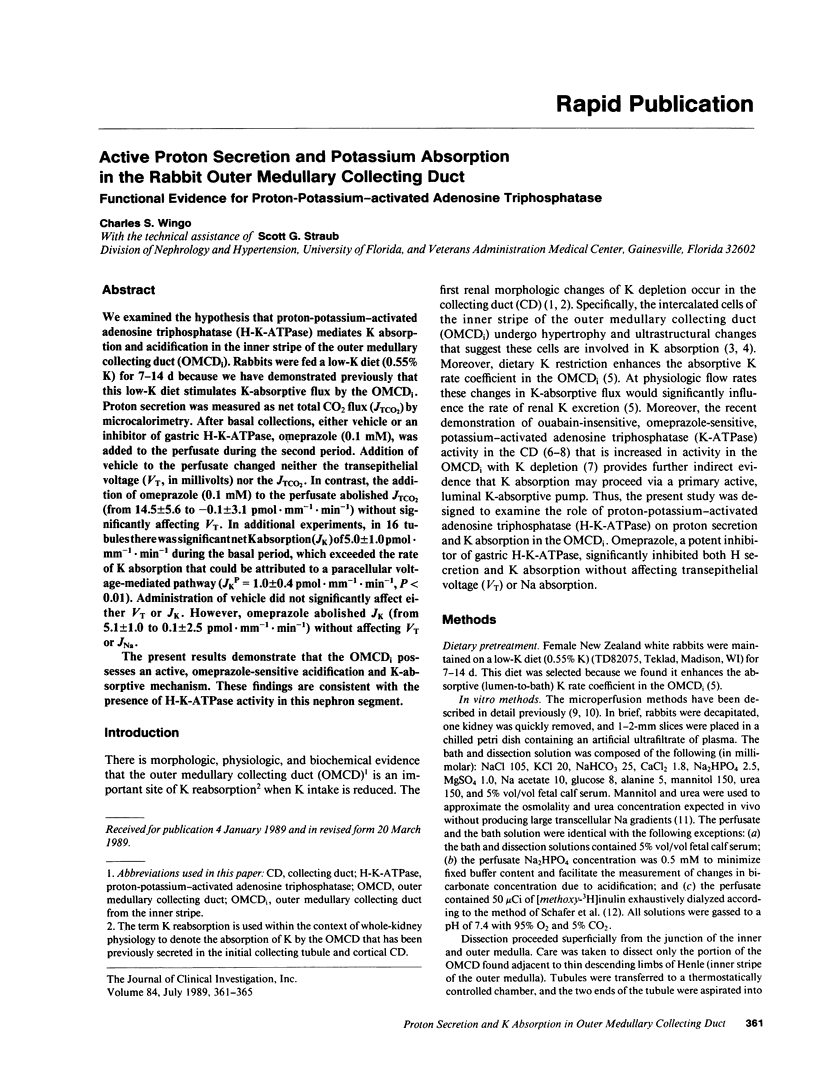
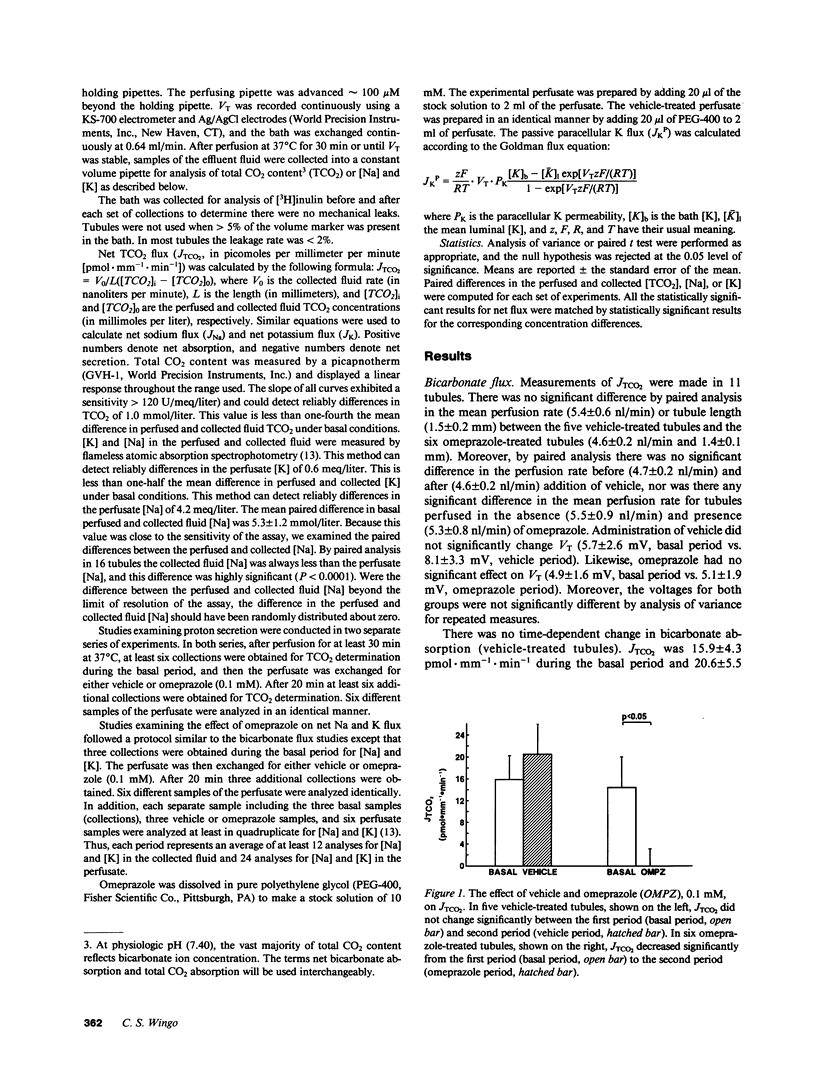
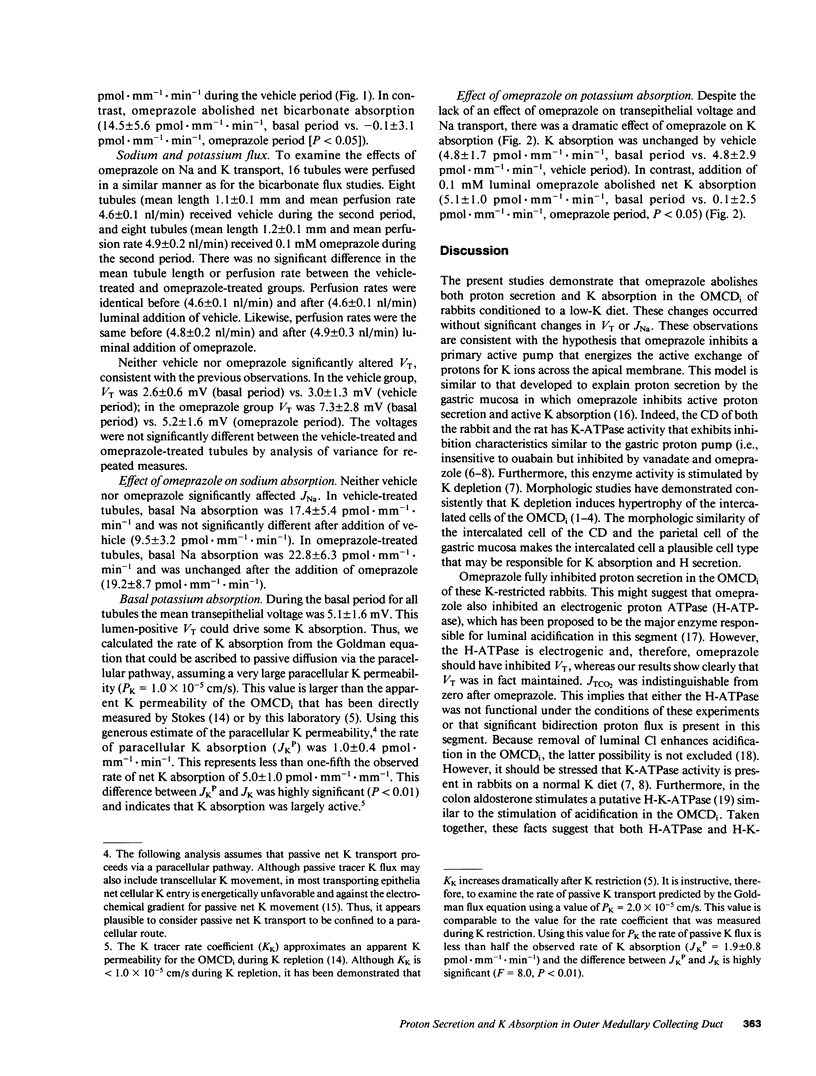
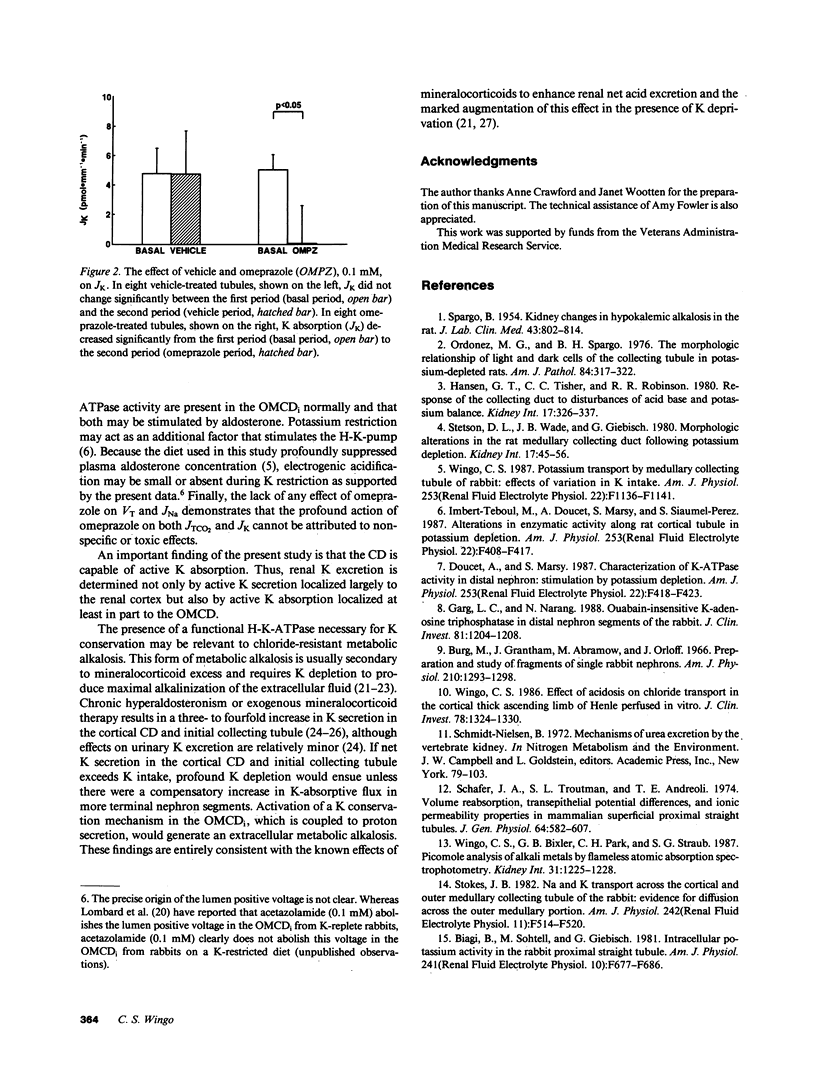
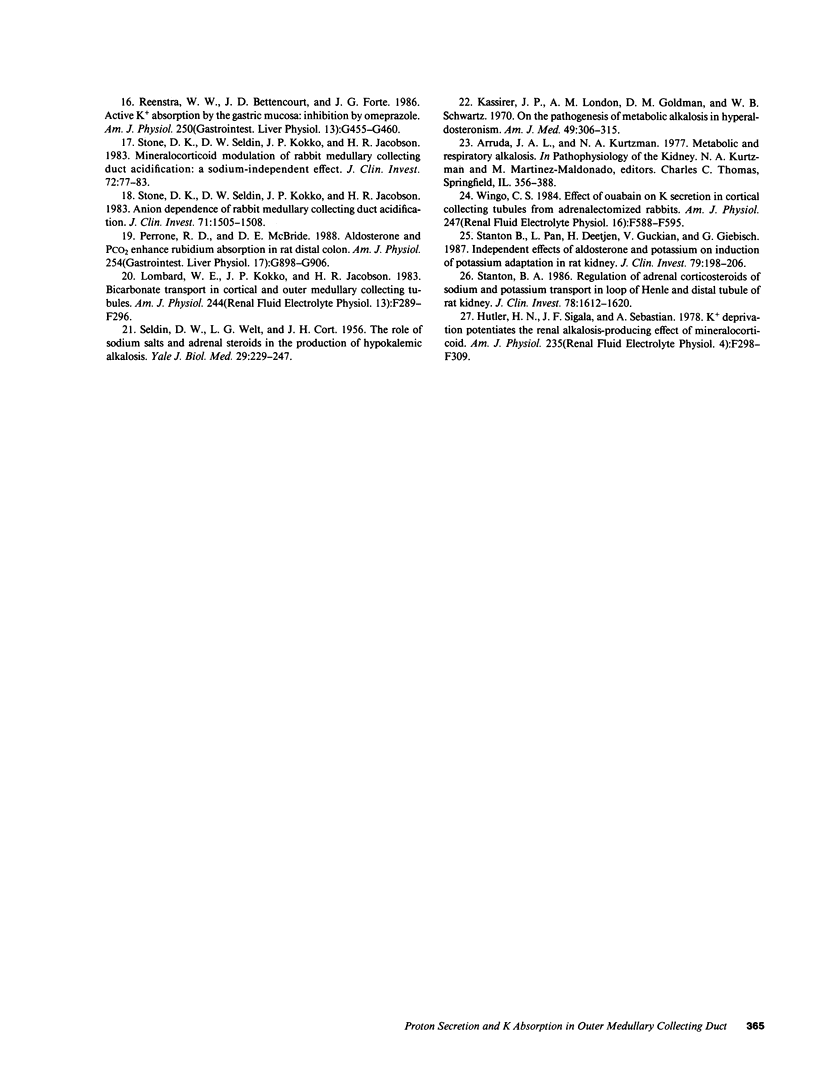
Selected References
These references are in PubMed. This may not be the complete list of references from this article.
- Biagi B., Sohtell M., Giebisch G. Intracellular potassium activity in the rabbit proximal straight tubule. Am J Physiol. 1981 Dec;241(6):F677–F686. doi: 10.1152/ajprenal.1981.241.6.F677. [DOI] [PubMed] [Google Scholar]
- Burg M., Grantham J., Abramow M., Orloff J. Preparation and study of fragments of single rabbit nephrons. Am J Physiol. 1966 Jun;210(6):1293–1298. doi: 10.1152/ajplegacy.1966.210.6.1293. [DOI] [PubMed] [Google Scholar]
- Doucet A., Marsy S. Characterization of K-ATPase activity in distal nephron: stimulation by potassium depletion. Am J Physiol. 1987 Sep;253(3 Pt 2):F418–F423. doi: 10.1152/ajprenal.1987.253.3.F418. [DOI] [PubMed] [Google Scholar]
- Garg L. C., Narang N. Ouabain-insensitive K-adenosine triphosphatase in distal nephron segments of the rabbit. J Clin Invest. 1988 Apr;81(4):1204–1208. doi: 10.1172/JCI113436. [DOI] [PMC free article] [PubMed] [Google Scholar]
- Hansen G. P., Tisher C. C., Robinson R. R. Response of the collecting duct to disturbances of acid-base and potassium balance. Kidney Int. 1980 Mar;17(3):326–337. doi: 10.1038/ki.1980.38. [DOI] [PubMed] [Google Scholar]
- Hulter H. N., Sigala J. F., Sebastian A. K+ deprivation potentiates the renal alkalosis-producing effect of mineralocorticoid. Am J Physiol. 1978 Oct;235(4):F298–F309. doi: 10.1152/ajprenal.1978.235.4.F298. [DOI] [PubMed] [Google Scholar]
- Imbert-Teboul M., Doucet A., Marsy S., Siaume-Perez S. Alterations of enzymatic activities along rat collecting tubule in potassium depletion. Am J Physiol. 1987 Sep;253(3 Pt 2):F408–F417. doi: 10.1152/ajprenal.1987.253.3.F408. [DOI] [PubMed] [Google Scholar]
- Kassirer J. P., London A. M., Goldman D. M., Schwartz W. B. On the pathogenesis of metabolic alkalosis in hyperaldosteronism. Am J Med. 1970 Sep;49(3):306–315. doi: 10.1016/s0002-9343(70)80021-3. [DOI] [PubMed] [Google Scholar]
- Lombard W. E., Kokko J. P., Jacobson H. R. Bicarbonate transport in cortical and outer medullary collecting tubules. Am J Physiol. 1983 Mar;244(3):F289–F296. doi: 10.1152/ajprenal.1983.244.3.F289. [DOI] [PubMed] [Google Scholar]
- Ordónez N. G., Spargo B. H. The morphologic relationship of light and dark cells of the collecting tubule in potassium-depleted rats. Am J Pathol. 1976 Aug;84(2):317–326. [PMC free article] [PubMed] [Google Scholar]
- Perrone R. D., McBride D. E. Aldosterone and PCO2 enhance rubidium absorption in rat distal colon. Am J Physiol. 1988 Jun;254(6 Pt 1):G898–G906. doi: 10.1152/ajpgi.1988.254.6.G898. [DOI] [PubMed] [Google Scholar]
- Reenstra W. W., Bettencourt J. D., Forte J. G. Active K+ absorption by the gastric mucosa: inhibition by omeprazole. Am J Physiol. 1986 Apr;250(4 Pt 1):G455–G460. doi: 10.1152/ajpgi.1986.250.4.G455. [DOI] [PubMed] [Google Scholar]
- SELDIN D. W., WELT L. G., CORT J. H. The role of sodium salts and adrenal steroids in the production of hypokalemic alkalosis. Yale J Biol Med. 1956 Dec;29(3):229–247. [PMC free article] [PubMed] [Google Scholar]
- SPARGO B. Kidney changes in hypokalemic alkalosis in the rat. J Lab Clin Med. 1954 May;43(5):802–814. [PubMed] [Google Scholar]
- Schafer J. A., Troutman S. L., Andreoli T. E. Volume reabsorption, transepithelial potential differences, and ionic permeability properties in mammalian superficial proximal straight tubules. J Gen Physiol. 1974 Nov;64(5):582–607. doi: 10.1085/jgp.64.5.582. [DOI] [PMC free article] [PubMed] [Google Scholar]
- Stanton B. A. Regulation by adrenal corticosteroids of sodium and potassium transport in loop of Henle and distal tubule of rat kidney. J Clin Invest. 1986 Dec;78(6):1612–1620. doi: 10.1172/JCI112754. [DOI] [PMC free article] [PubMed] [Google Scholar]
- Stanton B., Pan L., Deetjen H., Guckian V., Giebisch G. Independent effects of aldosterone and potassium on induction of potassium adaptation in rat kidney. J Clin Invest. 1987 Jan;79(1):198–206. doi: 10.1172/JCI112783. [DOI] [PMC free article] [PubMed] [Google Scholar]
- Stetson D. L., Wade J. B., Giebisch G. Morphologic alterations in the rat medullary collecting duct following potassium depletion. Kidney Int. 1980 Jan;17(1):45–56. doi: 10.1038/ki.1980.6. [DOI] [PubMed] [Google Scholar]
- Stokes J. B. Na and K transport across the cortical and outer medullary collecting tubule of the rabbit: evidence for diffusion across the outer medullary portion. Am J Physiol. 1982 May;242(5):F514–F520. doi: 10.1152/ajprenal.1982.242.5.F514. [DOI] [PubMed] [Google Scholar]
- Stone D. K., Seldin D. W., Kokko J. P., Jacobson H. R. Anion dependence of rabbit medullary collecting duct acidification. J Clin Invest. 1983 May;71(5):1505–1508. doi: 10.1172/JCI110905. [DOI] [PMC free article] [PubMed] [Google Scholar]
- Stone D. K., Seldin D. W., Kokko J. P., Jacobson H. R. Mineralocorticoid modulation of rabbit medullary collecting duct acidification. A sodium-independent effect. J Clin Invest. 1983 Jul;72(1):77–83. doi: 10.1172/JCI110986. [DOI] [PMC free article] [PubMed] [Google Scholar]
- Wingo C. S., Bixler G. B., Park C. H., Straub S. G. Picomole analysis of alkali metals by flameless atomic absorption spectrophotometry. Kidney Int. 1987 May;31(5):1225–1228. doi: 10.1038/ki.1987.132. [DOI] [PubMed] [Google Scholar]
- Wingo C. S. Effect of acidosis on chloride transport in the cortical thick ascending limb of Henle perfused in vitro. J Clin Invest. 1986 Nov;78(5):1324–1330. doi: 10.1172/JCI112718. [DOI] [PMC free article] [PubMed] [Google Scholar]
- Wingo C. S. Effect of ouabain on K secretion in cortical collecting tubules from adrenalectomized rabbits. Am J Physiol. 1984 Oct;247(4 Pt 2):F588–F595. doi: 10.1152/ajprenal.1984.247.4.F588. [DOI] [PubMed] [Google Scholar]


